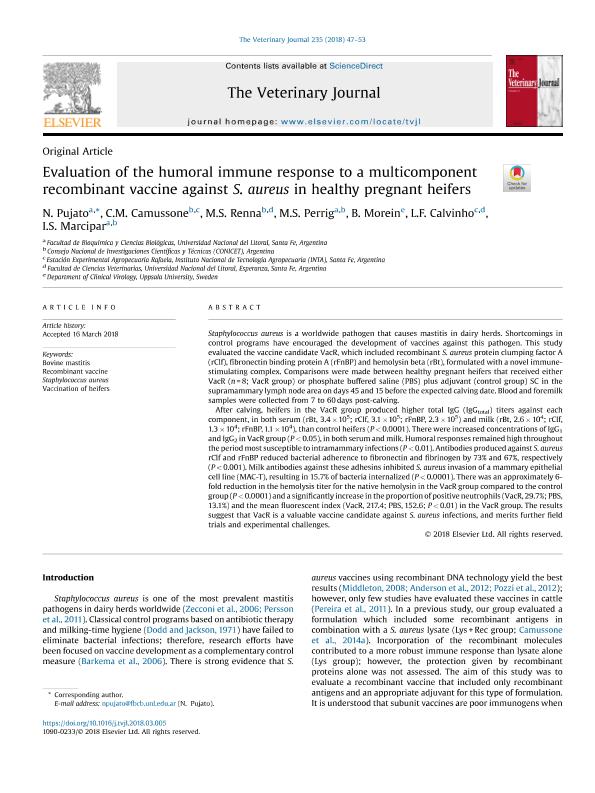Mostrar el registro sencillo del ítem
dc.contributor.author
Pujato, Nazarena

dc.contributor.author
Camussone, Cecilia María

dc.contributor.author
Renna, Maria Sol

dc.contributor.author
Perrig, Melina Soledad

dc.contributor.author
Morein Bror
dc.contributor.author
Calvinho, Luis Fernando

dc.contributor.author
Marcipar, Iván Sergio

dc.date.available
2020-10-31T20:48:35Z
dc.date.issued
2018-03
dc.identifier.citation
Pujato, Nazarena; Camussone, Cecilia María; Renna, Maria Sol; Perrig, Melina Soledad; Morein Bror; et al.; Evaluation of the humoral immune response to a multicomponent recombinant vaccine against S. aureus in healthy pregnant heifers; Elsevier; The Veterinary Journal; 235; 3-2018; 47-53
dc.identifier.issn
1090-0233
dc.identifier.uri
http://hdl.handle.net/11336/117346
dc.description.abstract
Staphylococcus aureus is a worldwide pathogen that causes mastitis in dairy herds. Shortcomings in control programs have encouraged the development of vaccines against this pathogen. This study evaluated the vaccine candidate VacR, which included recombinant S. aureus protein clumping factor A (rClf), fibronectin binding protein A (rFnBP) and hemolysin beta (rBt), formulated with a novel immune-stimulating complex. Comparisons were made between healthy pregnant heifers that received either VacR (n = 8; VacR group) or phosphate buffered saline (PBS) plus adjuvant (control group) SC in the supramammary lymph node area on days 45 and 15 before the expected calving date. Blood and foremilk samples were collected from 7 to 60 days post-calving. After calving, heifers in the VacR group produced higher total IgG (IgGtotal) titers against each component, in both serum (rBt, 3.4 × 105; rClf, 3.1 × 105; rFnBP, 2.3 × 105) and milk (rBt, 2.6 × 104; rClf, 1.3 × 104; rFnBP, 1.1 × 104), than control heifers (P < 0.0001). There were increased concentrations of IgG1 and IgG2 in VacR group (P < 0.05), in both serum and milk. Humoral responses remained high throughout the period most susceptible to intramammary infections (P < 0.01). Antibodies produced against S. aureus rClf and rFnBP reduced bacterial adherence to fibronectin and fibrinogen by 73% and 67%, respectively (P < 0.001). Milk antibodies against these adhesins inhibited S. aureus invasion of a mammary epithelial cell line (MAC-T), resulting in 15.7% of bacteria internalized (P < 0.0001). There was an approximately 6-fold reduction in the hemolysis titer for the native hemolysin in the VacR group compared to the control group (P < 0.0001) and a significantly increase in the proportion of positive neutrophils (VacR, 29.7%; PBS, 13.1%) and the mean fluorescent index (VacR, 217.4; PBS, 152.6; P < 0.01) in the VacR group. The results suggest that VacR is a valuable vaccine candidate against S. aureus infections, and merits further field trials and experimental challenges.
dc.format
application/pdf
dc.language.iso
eng
dc.publisher
Elsevier

dc.rights
info:eu-repo/semantics/openAccess
dc.rights.uri
https://creativecommons.org/licenses/by-nc-sa/2.5/ar/
dc.subject
BOVINE MASTITIS
dc.subject
RECOMBINANT VACCINE
dc.subject
STAPHYLOCOCCUS AUREUS
dc.subject
VACCINATION OF HEIFERS
dc.subject.classification
Tecnologías que involucran la identificación de ADN, proteínas y enzimas, y cómo influyen en el conjunto de enfermedades y mantenimiento del bienestar

dc.subject.classification
Biotecnología de la Salud

dc.subject.classification
CIENCIAS MÉDICAS Y DE LA SALUD

dc.title
Evaluation of the humoral immune response to a multicomponent recombinant vaccine against S. aureus in healthy pregnant heifers
dc.type
info:eu-repo/semantics/article
dc.type
info:ar-repo/semantics/artículo
dc.type
info:eu-repo/semantics/publishedVersion
dc.date.updated
2020-10-19T16:17:07Z
dc.journal.volume
235
dc.journal.pagination
47-53
dc.journal.pais
Países Bajos

dc.journal.ciudad
Amsterdam
dc.description.fil
Fil: Pujato, Nazarena. Universidad Nacional del Litoral. Facultad de Bioquímica y Ciencias Biológicas; Argentina
dc.description.fil
Fil: Camussone, Cecilia María. Consejo Nacional de Investigaciones Científicas y Técnicas; Argentina. Instituto Nacional de Tecnología Agropecuaria. Centro Regional Santa Fe. Estación Experimental Agropecuaria Rafaela; Argentina
dc.description.fil
Fil: Renna, Maria Sol. Consejo Nacional de Investigaciones Científicas y Técnicas. Centro Científico Tecnológico Conicet - Santa Fe. Instituto de Ciencias Veterinarias del Litoral. Universidad Nacional del Litoral. Facultad de Ciencias Veterinarias. Instituto de Ciencias Veterinarias del Litoral; Argentina
dc.description.fil
Fil: Perrig, Melina Soledad. Universidad Nacional del Litoral. Facultad de Bioquímica y Ciencias Biológicas; Argentina. Consejo Nacional de Investigaciones Científicas y Técnicas; Argentina
dc.description.fil
Fil: Morein Bror. Uppsala University; Suecia
dc.description.fil
Fil: Calvinho, Luis Fernando. Instituto Nacional de Tecnología Agropecuaria. Centro Regional Santa Fe. Estación Experimental Agropecuaria Rafaela; Argentina
dc.description.fil
Fil: Marcipar, Iván Sergio. Consejo Nacional de Investigaciones Científicas y Técnicas; Argentina. Universidad Nacional del Litoral. Facultad de Bioquímica y Ciencias Biológicas; Argentina
dc.journal.title
The Veterinary Journal

dc.relation.alternativeid
info:eu-repo/semantics/altIdentifier/url/https://www.journals.elsevier.com/the-veterinary-journal/
dc.relation.alternativeid
info:eu-repo/semantics/altIdentifier/doi/http://dx.doi.org/10.1016/j.tvjl.2018.03.005
Archivos asociados
